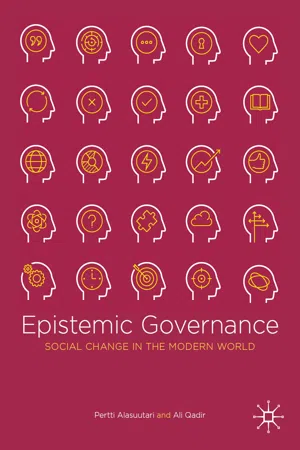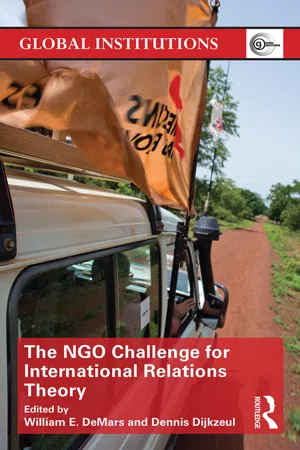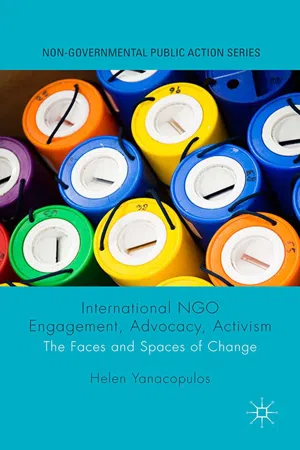IGOs
IGOs, or Intergovernmental Organizations, are entities formed by the cooperation of multiple governments to address common issues or achieve shared goals. These organizations, such as the United Nations or the European Union, play a significant role in shaping global governance, international relations, and addressing transnational challenges like climate change, trade, and security.
6 Key excerpts on "IGOs"
- eBook - ePub
Epistemic Governance
Social Change in the Modern World
- Pertti Alasuutari, Ali Qadir(Authors)
- 2019(Publication Date)
- Palgrave Macmillan(Publisher)
...© The Author(s) 2019 P. Alasuutari, A. Qadir Epistemic Governance https://doi.org/10.1007/978-3-030-19150-4_5 Begin Abstract 5. International Organizations Pertti Alasuutari 1 and Ali Qadir 1 (1) Tampere University, Tampere, Finland Pertti Alasuutari (Corresponding author) Email: [email protected] Ali Qadir Email: [email protected] End Abstract This chapter discusses the role of intergovernmental organizations (IGOs) in people’s endeavors to bring about change. We introduce different perspectives on IGOs and show how the theory of epistemic governance can be used in studying international organization. The chapter shows that IGOs have different profiles regarding their authority: some are respected as expert organizations, others as moral authorities, and IGOs may also market themselves as entities that can use force to impose their will on their member states and other actors in the world. IGOs are typically eclectic in amassing authority as epistemic capital: when several actors “borrow” the authority of an IGO, it increases and radiates also to the users, which is why IGOs and NGOs form advocacy coalitions and networks. With their roots in the infamous Club of Rome report, The Limits to Growth (Meadows, Meadows, Randers, & Behrens III, 1972), the United. Nation’s sustainable development goals (SDGs) are probably the most ambitious effort of the international community to steer global change. As a common denominator of a plethora of actors aiming for a sustainable future, the SDGs also manifest a long-term expansion of international non-governmental and governmental organizations (Bromley & Meyer, 2015), particularly with those concerned with the environment (J. W. Meyer, Frank, Hironaka, Schofer, & Tuma, 1997). In this chapter we use the SDGs as an illustration of the role of intergovernmental organizations (IGOs) in people’s endeavors to bring about change in the world...
- eBook - ePub
Governing Climate Induced Migration and Displacement
IGO Expansion and Global Policy Implications
- Andrea C. Simonelli, Kenneth A. Loparo(Authors)
- 2016(Publication Date)
- Palgrave Macmillan(Publisher)
...This structure would be one of the more concrete forms of governance within an architecture. The literature on IGOs focuses on the specific structural attributes of an organization, not on a conceptual entity like global governance scholarship. Early efforts to develop international governance have attempted to parallel domestic governance forms – especially federalism. Abbott and Snidal (1998) argue that replicating domestic governance is difficult in the anarchic structure of the international system. IGOs may be governed and created by their members, but are in essence not state-centric. They are member-centric, and powerful member states often exercise substantial and disproportionate influence over IGOs. Centralization is also limited, with many decisions made by consensus. IGOs are important centers of bureaucratic expertise, but rarely adopt mandatory rules, instead relying on individual states to ratify any treaty before it can take effect. The shortcomings of these organizations have given way to an alternative bodily configuration. Deemed “Emerging Transnational New Governance”, this updated form differs in that there is little state orchestration, it is highly decentralized, its expertise is disbursed, and agreements have become voluntary. Going one step further, Ingram et al. (2005) define IGOs as organizations that meet regularly, are formed by a treaty, and have three or more member states. Similarly, Bernauer et al. (2010) recognize such an organization as one with a permanent secretariat and one that holds regular meetings. Minnich (2005) argues that IGOs should be defined as those associations established by governments or their representatives that are institutionalized sufficiently to require regular meetings, decision making rules, and a permanent staff and headquarters. Additionally, they can be distinguished by their formal organization, purposeful activity, bureaucratic design, and legal personality...
- William E. DeMars, Dennis Dijkzeul(Authors)
- 2015(Publication Date)
- Routledge(Publisher)
...4 The co-evolution of non-governmental and intergovernmental organizations in historical perspective Bob Reinalda DOI: 10.4324/9781315728155-4 This chapter traces the emergence of non-governmental organizations and intergovernmental organizations (NGOs and IGOs) as part of wider changes in the international system of states. It does not take the traditional Westphalian state as its point of departure but looks upon the territorial state as a historical process, in which non-governmental actors have achieved their place as well. While most International Relations (IR) theory builds on sovereignty and warfare as the main characteristics of modern state building since 1648, this chapter includes the declaration of new ideas about “popular sovereignty” and “human rights” during the War of American Independence (1776) and the French Revolution (1789), as well as the transformation of these ideas into political reality through political struggle by citizens both nationally and internationally. It discusses the emergence of multilateralism at the Congress of Vienna (1814–15), which set in motion a number of innovations, inventions and learning processes, as a new phase of the Westphalian state. It also discusses the rise of private organizations with a public purpose, which were well aware of this new multilateralism and developed transnational networks in order to have a stronger power base within it. The growth of multilateral and follow-up conferences, which proved to be open to NGO influence, resulted in a process of institutionalization, with IGOs based on regular general assemblies, permanent secretariats, a professionalization of its staff and an open stance towards NGOs. The next phase of international organization was characterized by an increase in scale of international bureaucracies, including forms of control over NGOs...
- eBook - ePub
Diplomacy and Global Governance
The Diplomatic Service in an Age of Worldwide Interdependence
- Thomas Nowotny(Author)
- 2018(Publication Date)
- Routledge(Publisher)
...That makes for a sense of commonality just as a sense of commonality unites the citizens of a state. Those who participate in such a global web organized by an INGO can also provide it with material resources. Unlike governments, INGOs cannot impose taxes. But like governments they can raise money for their purposes. They have no army or police. Nonetheless they do have means to impress on others their views and interests. Humans now find it easier to organize politically also on a global level. We therefore witness the emergence of a global polity that stands next to the polity of citizens contained within the bounds of states. Events organized by INGOs at the fringes of big international conferences are proof for that. Delegates to these INGO meetings frequently outnumber the number of delegates that represent their respective states at such meetings. Nor are the two types of meetings simply in parallel, without any exchange taking place between them. At the World Bank/IMF annual meetings, a full day is usually given to encounters and discussions between the two sides. In the time between such major conferences, INGOs are routinely consulted by international organizations. They have provided substantial input, for example, in the articulation of criteria for sustainable development that projects of major international development banks have to meet. Yet with all these activities and with all of their resources, INGOs still represent a part of the political spectrum only. They fight for values and interests that are specific to some groups and not to others. States however, have to deal with many such groups in their internal politics. Trade unions press for higher wages. Industrialists exert pressure in the other direction. Environmental groups seek to preserve the purity of environment whereas farmers want to exploit the land...
- Daniel Thomas Cook(Author)
- 2020(Publication Date)
- SAGE Publications Ltd(Publisher)
...Studies show, in particular, that the expansion of INGOs in the Global South after the Cold War has filled the gaps left by the downsizing of the welfare state promoted by intergovernmental organizations like the World Bank and the International Monetary Fund. In many developing countries, tasks such as health, education, or basic social services, previously realized by the state are now ensured, often through small-scale and time-bound projects, by INGOs, usually working in partnership with local NGOs. Impact of INGOs In domains such as human, women, and children’s rights, INGOs have typically prioritized legal and procedural change, focusing their lobbying efforts on major intergovernmental organizations, like the League of Nations, during the interwar years, or its successor, the UN. Because of their growing professionalization, the legitimacy afforded by their field presence and the mobilization of increasingly broad networks of like-minded actors, including intergovernmental organizations, states, and academics, INGOs have steadily increased their capacity to influence international law and policies...
- eBook - ePub
International NGO Engagement, Advocacy, Activism
The Faces and Spaces of Change
- Helen Yanacopulos(Author)
- 2015(Publication Date)
- Palgrave Macmillan(Publisher)
...Almost by definition, INGOs that work in development are first and foremost trying to change a given situation. Whether they are providing basic services, setting up a school, or empowering women to become entrepreneurs, all are arguably inherently political acts. In addition, INGOs work across borders and at different scales, from the ‘local’ grassroots level, to those of global governance. This is captured by Lang (2013: 12) who claims that the INGO sector has been ‘credited with playing a central part in establishing new geographies of political power at the intersection of civil society and institutional politics’. In Ulrich Beck’s (2006) Cosmopolitan Vision, he argues that there are ‘other spaces’ produced as a result of such global changes. Both of these factors, taken in the context of the shifting landscapes enabled by the globalisation of information and communication technologies, from the Internet to the global media sphere, have produced the impression of space ‘shrinking’ and a rapid shifting of INGOs’ operating environments. Given these significant shifts, it is vital to look at the different political spaces that INGOs inhabit, and how they have utilised a range of different political terrains. Smith and Smythe (2009: 794) ask, ‘[W]hat will be the new vocabulary and spaces of politics?’ Attempting to suggest some answers to their question will provide the focus of the following five chapters. The idea of ‘opening up’ political spaces has become prevalent; it is an idea that has been used by political activists from the streets of the Arab Spring (Salih, 2014) to the contagious Occupy movement, 1 and to the various regional and World Social Forums (Sen, 2010). Terms such as ‘deliberative space’, ‘mediascapes’, ‘transnational spaces’ and ‘virtual – or digital – space’ are now widespread in the academic literature, as well as in the discourses of activists...





